 Abraham Lincoln
If given the truth, the people can be depended upon to meet any national crisis...
Abraham Lincoln
If given the truth, the people can be depended upon to meet any national crisis...
 Guildford news...
for Guildford people, brought to you by Guildford reporters - Guildford's own news service
Guildford news...
for Guildford people, brought to you by Guildford reporters - Guildford's own news service
How Guildford Played Its Part In The Dunkirk Evacuation 80 Years Ago
Published on: 29 May, 2020
Updated on: 29 May, 2020
It is now 80 years since the Dunkirk evacuation – ‘one of the miracles of the Second World War’ – when an estimated 338,000 Allied troops were rescued from France and brought back to Britain as the German Nazi army advanced towards them. Here DAVID ROSE looks at how Guildford played its part as scores of trains passed through the station with troops who had been rescued. It features how the local press reported the events and includes two fascinating personal accounts that he has not written about before.
Germany’s blitzkrieg (lightning war) was ripping through France and by May 20, 1940, its troops had reached the Channel coast. On May 24, with the British Expeditionary Force (BEF) cut off, it was decided to evacuate them through the port of Dunkirk. The operation was code-named ‘Dynamo’.
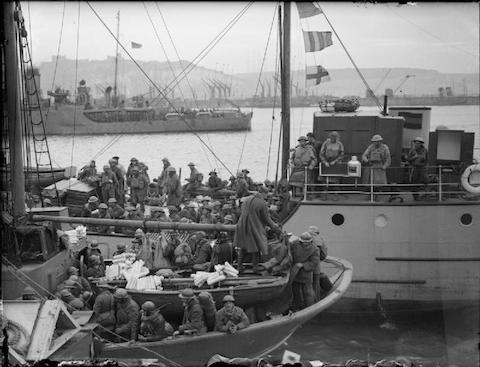
Allied troops being evacuated from the beaches at Dunkirk during the Second World War. Picture: Wikimedia Comms, Imperial War Museum.
As thousands of troops converged upon the beaches around the port of Dunkirk, a flotilla of naval ships and privately-owned boats set sail from Britain to assist in the rescue mission.
As May 27 drew to a close, 7,669 had arrived back in Britain. The rescue reached a peak on May 31 when 68,014 were removed from the beach on that day.
Most fortunately, the German advance had been halted for a few days, giving precious time for the rescue mission. However, the Nazis advanced again and the evacuation came to a halt on June 4.
As well as troops who had been killed, there were many others who were not rescued – one of whom’s story is told later.
Britain’s ‘big four’ railway companies went into rapid action to convey the rescued troops from the costal ports to destination points across the country, such as army camps and hospitals.
It is amazing to consider that details of Operation Dynamo were not received by the Southern Railway at its wartime HQ in Dorking until 5pm on Sunday, May 26, 1940.
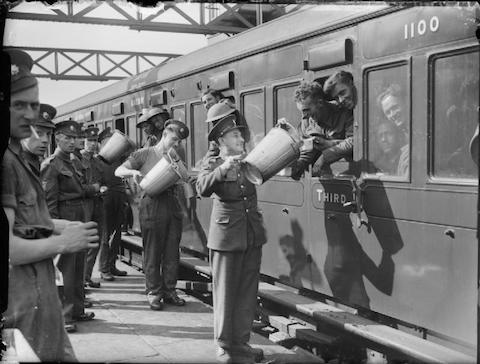
Not Guildford! Refreshments being given to soldiers on a Dunkirk evacuation troop train at Addison Road station (now Kensington (Olympia) station) on May 31, 1940. Picture: Wikimedia Comms, Imperial War Museum. Note: I have never seen any photos of similar scenes at Guildford railway station.
Hundreds of trains were run throughout the period of the evacuation, many routed from the Kent coast through Redhill, a good number of those passed through Guildford, some stopping in the station.
However, what not often appears to be told in the story of the evacuation of troops from France is that they had been had been arriving back in Britain earlier in May 1940.
It its edition of May 18, 1940, under the heading SICK AND INJURED SOLDIERS, the Surrey Advertiser reported: “Guildford received its first big convoy of soldiers evacuated from France on Sunday night. Mostly sick and injured men who had been transferred from base hospitals, they came by hospital train and reached Guildford Railway Station at 10pm, their arrival being witnessed by a large crowd, although the news that the train was expected was not generally known.
“About half of the convoy of men who arrived were walking cases. Despite their ailments and injuries, the men were in excellent spirits. A fleet of ambulances awaited the arrival of the train at the siding. Half of the men were removed to the Royal Surrey County Hospital and half to the Warren Road Hospital. The more severe cases were detrained first and conveyed in St John ambulances. The walking cases and some of the less serious ones were conveyed in buses, which had been commandeered for ambulance purposes, and in A.R.P sitting cars. The detraining of the men was carried through with the utmost smoothness and completed in two hours.”
The Surrey Advertiser of June 1, 1940, gave details of Dunkirk the evacuation under the headline WOUNDED ARRIVE / SOME WITH BURNS FROM BLAZING OIL. The report stated: “Wounded soldiers arrived by train in Surrey on Sunday evening and were taken to hospitals in the county.
“There were a few British among the 215 men, but most of them were French and other allied troops.
“All but 35 were stretcher cases, and many of them had been severely burned about the head and hands. They had been in the sea awaiting evacuation when oil on the water was set alight by the enemy. In spite of their injuries they maintained a good spirit.”
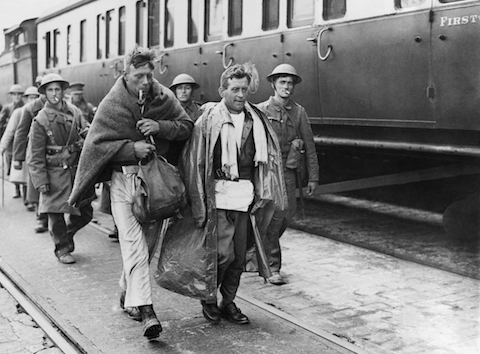
These troops were pictured at Dover on May 31, 1940. Picture: Wikimedia Comms, Imperial War Museum.
A Surrey Advertiser reporter was allowed on to Guildford railway station to witness the scenes as the trains stopped and refreshments were given to the weary troops.
The reporter later wrote: “On the platform were steaming jugs containing tea, trays with glasses of lemonade, rolls, chocolate, cakes and cigarettes. Dozens of helpers were quickly handing them in at the open windows to the surprised gratifications of the occupants and expressions of appreciation were heard on all sides. Postcards were handed in, messages hastily written, and the cards given back for posting. Then the whistle was sounded and the train moved off to cries of ‘au revoir’.”
One of those on the station helping was an aunt of mine, Winnie Rose, one of my dad’s two sisters. Sadly she died in 1943. However, my other aunt, Doris, later told me that Winnie worked in the station buffet. Winnie told Doris at the time she “would always remember seeing those soldiers, especially the ones who had lost limbs”.
It appears one of Guildford’s other newspapers, the Surrey Times, also had a reporter or an eye witness on the station. In its edition of June 8, 1940, it noted: “Standing on the platform at Guildford station on Saturday [June 1] and assisting and meeting the wants of these men, one was amazed at their morale.
“Nerve-shattering as had been their experience, not a man had a cowed look. Grim determination seemed manifest on every face; true they were tired – dog tired – but they had an air of confidence and the knowledge that eventually they would triumph.
“Indescribable scenes of savagery had been witnessed by these men. One soldier – he was an accountant in civilian life – briefly mentioned the terrible slaughter of refugees from the air, the desolation that reigned over the fair towns of Flanders and North France and the inferno in the region of Dunkirk.
“A Guards corporal gave an epic picture of holding his outpost on the Friday night. Then, under the cover of naval barrage, retiring from the woods to the beach. Here they were swept by machine-gun fire. Then came the order to wade out into the boats. Again more machine-gun fire and bombs dropping. Finally, he and his companions were on a destroyer. Before long a bomb struck the destroyer; another destroyer came alongside and they were re-embarked. Still the attack from the air prevailed, and this destroyer was also hit. The ship listed badly but, he added, “we were all taken off by a third destroyer. Throughout this ordeal the Navy carried on without ceasing. Even when struck the destroyers continued to fire. Spitfires came on the scene, and for the rest of the journey we were unmolested’.”
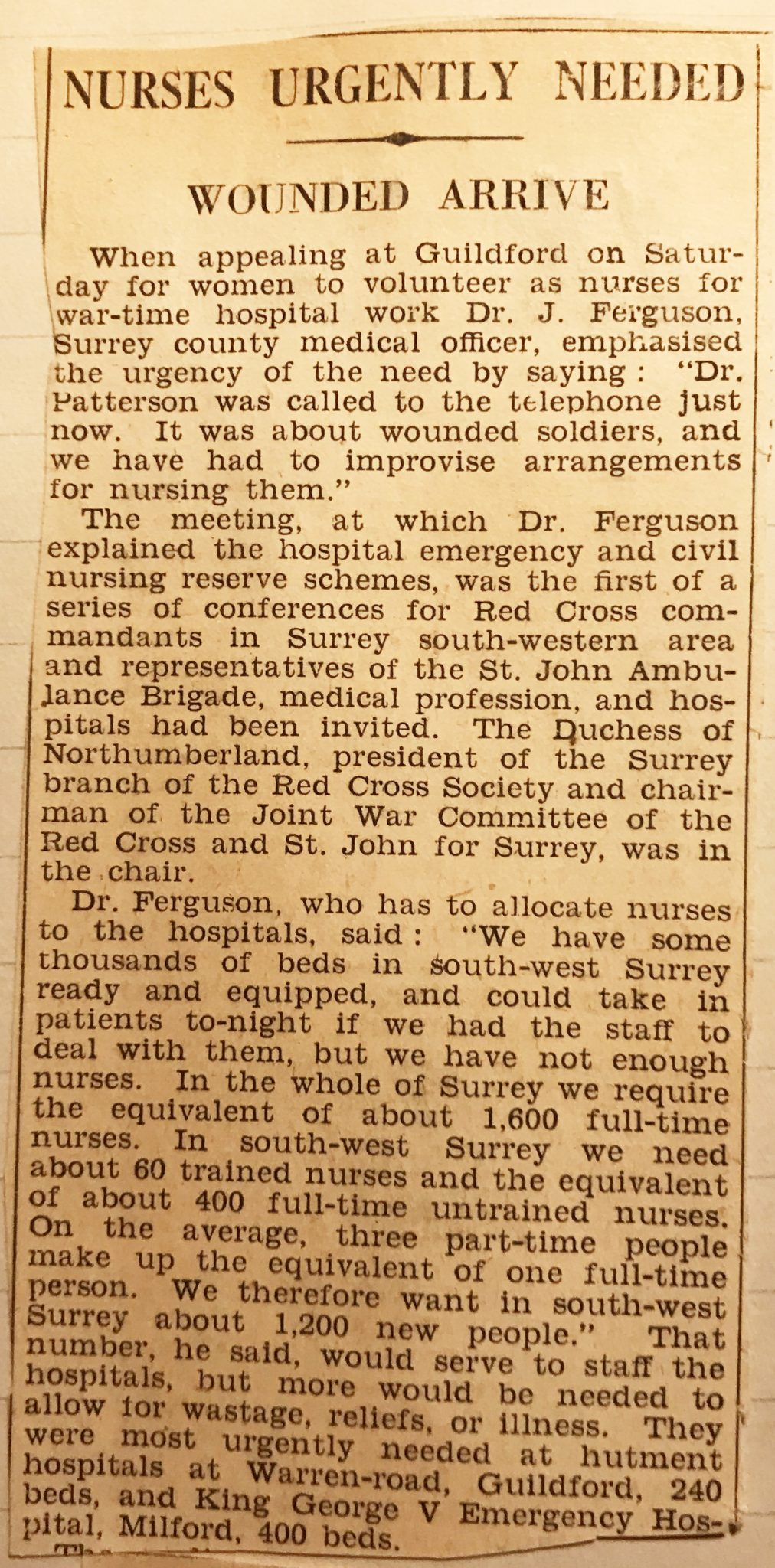
From the Surrey Advertiser of June 1, 1940, a story appealing for women to volunteer as nurses for wartime hospital work, presumably to help look after injured soldiers evacuated from France. Click to enlarge in a new window.
A story my mum told me when I was quite young and as I began to learn about the Second World War (and often pestered them for stories) was of a family friend who was one of those rescued during Operation Dynamo.
He just happened to be on one of the troop trains that stopped at Guildford. It being his home town, he managed to get off the train (strictly not allowed, of course) and made he way back home to 88 Worplesdon Road, Stoughton.
His name was Frank Westmacott. As no-one was at home when he arrived, he popped round to my grandparents home in Baden Road, where my mum (in her late teens) and some of her siblings all lived at the time. She recalled that they gave him a cup of tea, and as he told them of his ordeal an aircraft flew over – the noise of its engine making him dive for cover!
They had to reassure him by saying: “Don’t worry Frank, it’s only one of ours.”
I did meet him a few times as I was growing up, but of course I was too shy to ask him about his wartime experiences.
However, some years ago now, I met Ron May from Shalford, who knew my dad. He was once well known in the village and was a long-standing and prominent member of the Witley Motorcycle Club.
Ron mentioned to me that he was with the BEF in France in the spring of 1940 and was one of those who was not evacuated from Dunkirk, and therefore left behind.
The story he told was the he and some of his fellow troops had an army lorry and decided to make their way to the coast in Brittany. I’m not sure how they got there without being captured by the Germans, but they did get there, despite going three days without any rations at all!
They made their way to the port of Breast and sailed back to Britain courtesy of a French fisherman.
Sources of information for parts of this feature in addition to contemporary local newspaper reports:
Guildford The War Years 1939-45 by Graham Collyer and David Rose, Breedon Books 1999.
The Railway Magazine, May 2020 edition, pages 41-43, The Southern’s Finest Hour.
Responses to How Guildford Played Its Part In The Dunkirk Evacuation 80 Years Ago
Leave a Comment Cancel replyPlease see our comments policy. All comments are moderated and may take time to appear.

"Found any?" - "Nope, it all looks green to me!" (See Opinion: The Future is Congested, the Future is Grey)
www.abbotshospital.org/news/">





Recent Articles
- Latest Evidence in Sara Sharif Trial
- Ash’s New Road Bridge Is Named – and November 23rd Is Opening Day
- Class A in Underwear Leads to Jail Sentence
- Historical Almshouse Charity Celebrates Guildford in Bloom Victory
- Notice: Shalford Renewable Showcase – November 16
- Firework Fiesta: Guildford Lions Club Announces Extra Attractions
- Come and Meet the Flower Fairies at Watts Gallery
- Updated: Royal Mail Public Counter in Woodbridge Meadows to Close, Says Staff Member
- Letter: New Developments Should Benefit Local People
- Open Letter to Jeremy Hunt, MP: Ash’s Healthcare Concerns


Recent Comments
- Paul Spooner on Ash’s New Road Bridge Is Named – and November 23rd Is Opening Day
- Harry Eve on Opinion: The Future is Congested, the Future is Grey
- Nigel Keane on Letter: New Developments Should Benefit Local People
- Nathan Cassidy on Updated: Royal Mail Public Counter in Woodbridge Meadows to Close, Says Staff Member
- T Saunders on Opinion: The Future is Congested, the Future is Grey
- Jim Allen on Updated: Royal Mail Public Counter in Woodbridge Meadows to Close, Says Staff Member
Search in Site
Media Gallery
Dragon Interview: Local Artist Leaves Her Mark At One of England’s Most Historic Buildings
January 21, 2023 / No Comment / Read MoreDragon Interview: Lib Dem Planning Chair: ‘Current Policy Doesn’t Work for Local People’
January 19, 2023 / No Comment / Read MoreA3 Tunnel in Guildford ‘Necessary’ for New Homes, Says Guildford’s MP
January 10, 2023 / No Comment / Read More‘Madness’ for London Road Scheme to Go Ahead Against ‘Huge Opposition’, Says SCC Leader
January 6, 2023 / No Comment / Read MoreCouncillor’s Son Starts Campaign for More Consultation on North Street Plan
December 30, 2022 / No Comment / Read MoreCounty Council Climbs Down Over London Road Works – Further ‘Engagement’ Period Announced
December 14, 2022 / No Comment / Read MoreDragon Interview: GBC Reaction to the Government’s Expected Decision to Relax Housing Targets
December 7, 2022 / No Comment / Read MoreHow Can Our Town Centre Businesses Recover? Watch the Shop Front Debate
May 18, 2020 / No Comment / Read More



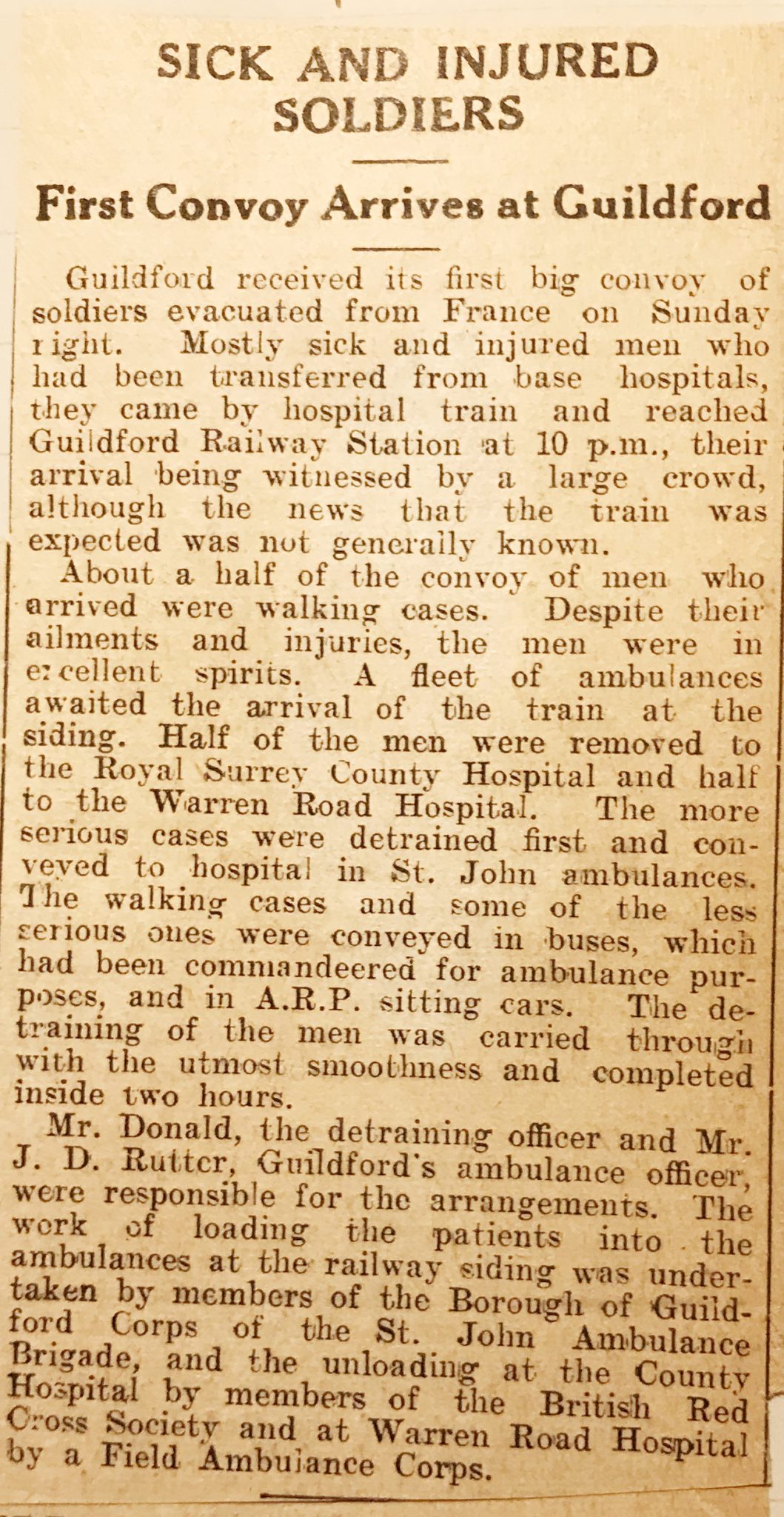




Alix Tatlow
May 29, 2020 at 3:30 pm
Readers might also be interested to read my brother Peter Tatlow’s book, “Return from Dunkirk; Railways to the Rescue – Operation Dynamo (1940)” – The Oakwood Press 2010.
It includes many references to our locality and tells the personal story of my father Alan Tatlow’s deliverance. He was a 2nd Lt in the 1/6th East Surrey Regiment. He wrote a moving poem a few days later as an attempted catharsis, which can be found in the Surrey History Centre.
Doreen Fielden (Mrs)
May 29, 2020 at 7:16 pm
I remember my mum telling me about seeing the trains full of soldiers coming through Guildford. Mum & Dad were married at Emmanuel Church, Stoughton on June 8 1940. Dad had sent a telegram a week before saying that his first home leave was due & she had one week to borrow wedding dresses & arrange everything. Harrowing times.